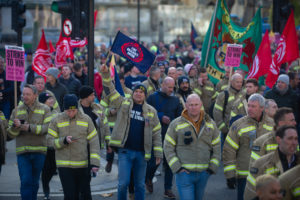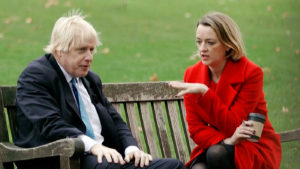I felt oddly cheerful last Friday evening as I trudged home through the snow, forsaken by public transport that had stopped running. The truth is that, like Slade or Morecambe and Wise, strikes bring back poignant memories of the Christmases of my youth. At the time, picket lines, power cuts and hysterical articles claiming democracy was about to collapse seemed like part of the natural order. But, of course, the strikes of the Seventies were not simply part of the natural order, any more than the relative quiescence of organised labour in the decades that followed. And, with strikes set to bring much of Britain to a standstill this winter, it is worth putting the sudden and noisy resurgence of working-class protest in historical context.
For almost a century, the question of how to deal with the working class was at the centre of British politics. This period stretched from 1884, when the Third Reform Act enfranchised a significant group of working-class men for the first time, until March 1985, when those miners who had stayed on strike for a year staged a last show of defiance by marching back to work behind their colliery bands. Of course, the working class mattered to the Labour Party (which became the dominant party on the Left after the First World War). The trade unions were the pillars of the Labour Party. Most of its voters were drawn from this class — as were, at least at first, a certain number of its MPs.
But in a more complicated way, the working class mattered to the Conservatives, partly because they needed to contain its power, but also because they needed to win at least some working-class votes if they were to form a government. And the fact that Britain was ruled by mainly Conservative governments for most of the 20th century shows how successful they were.
When did things change? The Labour Party under the leadership of Jim Callaghan from 1976 to 1980 was closer to the trade union movement than at any point before 1914. But, perhaps for this reason, it was troubled by the number of strikes — often ones that involved a breakdown of union power rather than its assertion. The Conservative Party under Margaret Thatcher’s leadership from 1975 still assumed that it was going to have to live with a large industrial working class; the party came to power in 1979 aiming to revive British industry, not destroy it. It also came to power with a surprisingly large working-class vote. Such voters had often voted Tory in earlier times in spite of being working-class (because they were deferential to those they imagined to be their social betters or because many voters, especially women, didn’t identify as working-class at all).
In 1979, however, some voted Tory because they were working-class. This was partly because they were voting against the various forms of pay restraint that the Labour government had practised (Thatcherite faith in monetarism meant that they were the first significant group of politicians since the Sixties who thought that government might simply absent itself from private-sector pay negotiations). The Tories also actively courted working-class voters in 1979 and for a couple of years afterwards. Watch Norman Tebbit (then Secretary of State for Employment) giving his “On yer bike” speech to the Tory Party conference in 1981. He is wearing a badge that says “CTU”: the initials stand for Conservative Trade Unionist.
Of course, the Tories wanted to reduce trade union power and, in particular, to break the National Union of Mineworkers. All Conservatives had wanted this for the whole of the 20th century. The desire was, in fact, particularly strong in the non-Thatcherite section of the party — it was, after all, Heath who had been destroyed by his confrontation with the NUM in 1974. However, the desire of the Tories to break the miners in 1979 was a bit like the desire of 16-year-old boys to sleep with Debbie Harry out of Blondie. They fantasised about it but did not think it likely to happen, or have any concrete plans to bring it about.
Indeed, the Thatcher government was nervous of the miners and backed down quickly when faced with potential strike in February 1981. But then Arthur Scargill became leader of the NUM. He took it into a strike in the worst possible circumstances, just after a Tory election victory, at the end of winter and after he had exasperated other union leaders and a significant minority of his own members. The Tories could not believe their luck. It was as though Ms Harry had stepped out of the poster on the bedroom wall and laid her head on their pillow.
The defeat of the miners changed the British working class. The miners themselves had once been its archetypical representatives — there had been over a million of them just after the First World War. Their numbers had been declining for decades but that decline became dramatic after 1985. By the early part of the next decade there were more university teachers than miners in the United Kingdom. Other unions were now wary of going on strike. Since the unions were often strongest in the public sector, privatisation (which took off after 1985) was both a cause and a consequence of weaker unions.
All of this fitted into to longer term changes. The total number of manual workers had been declining since the Sixties. The working class was increasingly divided — by sex or race, or by the growing difference between public sector workers (who were increasingly likely to be white collar and female) and those in the private sector. The working class also became less visible in a literal sense. In the Seventies, you could catch the 63 bus from Birmingham city centre and tell, almost at a glance, which of the passengers belonged to which class — you could, in particular, have a very good guess as to who was going to get off at the stop by the university and who would stay on until they reached the giant Longbridge car factory. You could hardly do that now (not least because Longbridge closed almost 20 years ago).
The miners’ strike has lodged itself in the public and historical memory, and this fascination springs partly from the fact that it seems so archaic. It involved an entirely male and almost entirely white group of workers who earned their living by hard and dangerous manual labour and worked for a single nationalised company. It seemed to mark the end of a struggle that had begun in 1926 and rapidly became associated with the end of a whole industry. Mining now plays a strange part in the British self-image. Almost no coal has been dug for years but people still talk of “pit villages”. The NUM is still, in an odd way, one of the most important unions in Britain, fighting for the rights of former miners and curating the memory of the “great strike”.
Focus on the miners has, however, had odd effects on how we see the working class. For one thing, the emphasis on a single, long strike involving a large number of workers is as deceptive as trying to understand contemporary warfare with reference to Western Front in 1916. Even before Scargill led his followers to defeat, most union leaders understood that the working-class is, almost by definition, weak. Outright confrontation with an employer or government was dangerous. Strikes now are short and intermittent. They are conducted by people who are often ostentatiously reasonable in their aims. The post-Scargill leaders of today have learned the hard lessons of the mid Eighties as much as the pre-Scargill leaders remembered the hard lessons of the Thirties.
An emphasis on the numerical strength or weakness of the working class can also be deceptive. In many ways, the most successful strike of the Seventies was not that of the miners which brought down the Heath government but that organised by the Ulster Workers’ Council a few months later. A relatively small number of workers (rendered more powerful by the fact that Protestants monopolised the best paid and most important jobs) were able to bring the province to a halt and force the government to abandon plans to introduce power sharing between Protestants and Catholics. The Conservatives, by now in opposition, studied the strike carefully. It taught them how much power might be exercised by small numbers of workers in key positions. They showed how well they had learned their lesson in 1984. The defeat of the miners was partly rooted in a willingness to appease other unions whose members might have helped the miners. The relatively high pay of train drivers now derives partly from the fact that they kept working during the miners’ strike.
In some ways, the previous balance of forces between workers and the middle classes has been reversed in recent years. Once, the great majority of the population were working-class but only occasionally and with difficulty could they assert their power in ways that redistributed wealth in their direction. Now a large part of the population has acquired attributes that would once have been associated with the middle class. They are likely to do white collar jobs, to own their own homes and to send their children to university — indeed access to university and to the “property ladder” are often foci for Left-wing complaint.
A small working class is not, however, necessarily a weak one. Covid illustrated the sharp distinction between those whose presence in the workplace was required and those who could work from home: “Virtuals” and “Physicals”. I am not sure that people have yet fully grasped the importance of this distinction. Anyone who can do their job from their bedroom will have shown their employer that their job can be done by someone much cheaper in Chennai or Manila. It will take a long time for employers (especially in the public sector) to act on this lesson but it will happen.
In recent years, it can seem as though the working class is a matter of purely historical interest — in universities, it feels as though even historians who once worked on the working class belong to the past. E.P. Thompson is often talked about as a quaint relic of a bygone age. Mobilisations around gender and race have attracted far more interest. If economic divisions are discussed at all, they are presented as ones that divided “the people” from the “1%” — as though an equitable division of wealth would be arranged in a manner that caused no inconvenience to anyone who is not a partner at Goldman Sachs.
Strikes, of course, bring back a simple question. How essential is your job and who would notice if you stopped doing it? After each strike by university teachers, we get a polite note from the administration asking us to specify which days we were on strike. I am guessing that Avanti do not need to ask the driver who is responsible for taking the 8.10am out of Euston whether or not he turned up for work. I doubt if there is going to be a great resurgence of working-class power, partly because the working class was never that powerful even when it was most unionised. But some workers have begun to realise again that withdrawal of labour is a powerful weapon — and one that may reveal how much the distinction between manual and non-manual workers still matters.
Disclaimer
Some of the posts we share are controversial and we do not necessarily agree with them in the whole extend. Sometimes we agree with the content or part of it but we do not agree with the narration or language. Nevertheless we find them somehow interesting, valuable and/or informative or we share them, because we strongly believe in freedom of speech, free press and journalism. We strongly encourage you to have a critical approach to all the content, do your own research and analysis to build your own opinion.
We would be glad to have your feedback.
Source: UnHerd Read the original article here: https://unherd.com/




